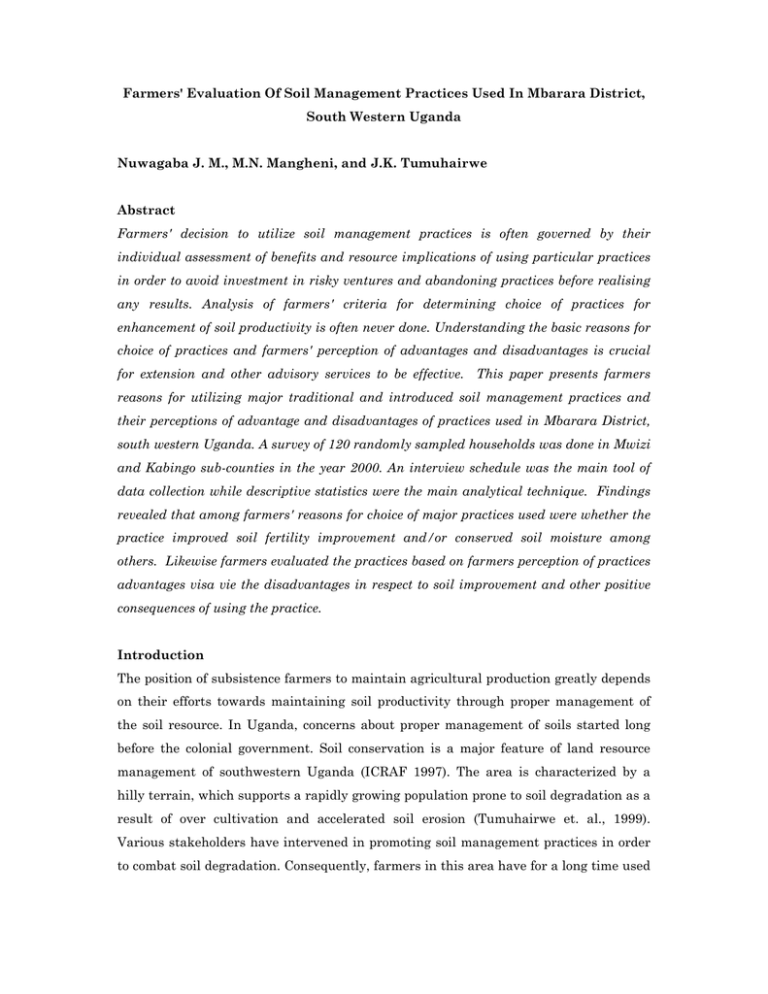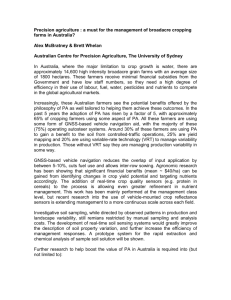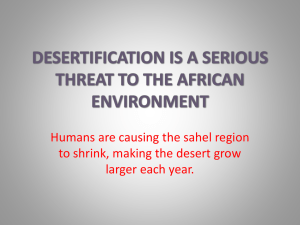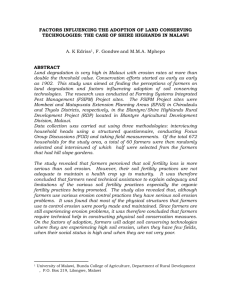Farmers' Evaluation Of Soil Management Practices Used In Mbarara District,
advertisement

Farmers' Evaluation Of Soil Management Practices Used In Mbarara District, South Western Uganda Nuwagaba J. M., M.N. Mangheni, and J.K. Tumuhairwe Abstract Farmers' decision to utilize soil management practices is often governed by their individual assessment of benefits and resource implications of using particular practices in order to avoid investment in risky ventures and abandoning practices before realising any results. Analysis of farmers' criteria for determining choice of practices for enhancement of soil productivity is often never done. Understanding the basic reasons for choice of practices and farmers' perception of advantages and disadvantages is crucial for extension and other advisory services to be effective. This paper presents farmers reasons for utilizing major traditional and introduced soil management practices and their perceptions of advantage and disadvantages of practices used in Mbarara District, south western Uganda. A survey of 120 randomly sampled households was done in Mwizi and Kabingo sub-counties in the year 2000. An interview schedule was the main tool of data collection while descriptive statistics were the main analytical technique. Findings revealed that among farmers' reasons for choice of major practices used were whether the practice improved soil fertility improvement and/or conserved soil moisture among others. Likewise farmers evaluated the practices based on farmers perception of practices advantages visa vie the disadvantages in respect to soil improvement and other positive consequences of using the practice. Introduction The position of subsistence farmers to maintain agricultural production greatly depends on their efforts towards maintaining soil productivity through proper management of the soil resource. In Uganda, concerns about proper management of soils started long before the colonial government. Soil conservation is a major feature of land resource management of southwestern Uganda (ICRAF 1997). The area is characterized by a hilly terrain, which supports a rapidly growing population prone to soil degradation as a result of over cultivation and accelerated soil erosion (Tumuhairwe et. al., 1999). Various stakeholders have intervened in promoting soil management practices in order to combat soil degradation. Consequently, farmers in this area have for a long time used both traditional and introduced soil management practices basing on both indigenous knowledge and introduced techniques by government ext. staff and NGO’s. Farmer's perception of the different soil management practices determine the choice to utilize them. In addition farmers decisions in land management are not separate from decisions on production, consumption and social control (Brookfield 1989). Farmers use various frames of reference in appraising the relevance and usefulness of research and development products accessible to them. In appraising interventions from various sources, farmers refer to the expected added value in respect to the farmers' objective functions, practicability of what is being proposed and its fit within the on going farmers practices (Opio-Odongo, 1999). Hence effective research among others would depend on effort made to understand and document the basis for decisions at farm level, especially the reasons why farmers manage natural resources as they do (Loevinsohn and Wangati, 1993) Consideration of references used by farmers in appraising different interventions is crucial in promoting relevant soil management practices in order to achieve sustainable soil productivity. Involving farmers' in evaluation of the various practices would help researchers to develop acceptable and affordable technical options and suggest more effective extension approaches (Loevinsohn and Wangati, 1993). Methodology This study was part of a broader study on characterization and evaluation of a UNU collaborate project on agrodiversity and agro-biodiversity (People, Land management and environmental change PLEC project). A survey was conducted in Mwizi and Kabingo sub counties in Mbarara District, south western Uganda. The target population was 6,028 farming households in Bushwere and Kamuri parishes where PLEC project was developing demonstration sites for promoting sustainable approaches to land management and agricultural bio-diversity conservation. A total number of 20 villages were covered of which 8 were in Kamuri parish and 12 in Bushwere parish. Using a systematic random sampling technique, 120 households were selected for the study. This involved drawing the sample by taking every kth case from the population per village and because of variation of the total number of households in each village, the interval between every kth case was different per village varying between 8 and 10. The main instrument for data collection was a semi-structured interview schedule, which was tested for both its content validity and reliability on two other parishes, neighbouring the study sites. Experts in the field of Agricultural Extension and Soil Science determined content validity of the instrument. Reliability was determined using the test-retest method. The interval between testings was 2 weeks. Results of the two administrations were correlated and reliability coefficient ranged from 0.69 to 0.74. Data was analysed using the statistical package for social sciences (SPSS) and summarized using tables. Results And Discussions Major traditional and introduced soil management practices used Diversity of soil management practices was evident in both Mwizi and Kabingo sub counties. Over fifteen traditional and five introduced practices were reported but in order to do an in-depth analysis, it was found reasonable to reduce the practices to a manageable number. Hence arbitrary percentages used as cut off points were used to determine the major traditional and introduced soil management practices. The major traditional practices were defined as those that were used by 70% and above of the total respondents and the major introduced practices as those utilized by 20% and above of the total respondents. The major traditional and introduced soil management practices are presented in table 1. Table 1: Major soil management practices (n=120) Traditional practices Frequenc % y Introduced Frequenc practices y % Mulching 110 91.7 Trenches 57 47.5 Household 109 90.8 Controlled bush and 44 36.7 Waste utilisation trash burning Crop rotation 92 76.7 Inter cropping 90 75.0 Rough tillage 110 91.7 Fine tillage 96 80.0 Soak pits 27 22.5 Mulching and household wastes utilization were the most commonly used traditional practices (over 90%) because all farmers in both Mwizi and Kabingo sub counties grow bananas where these practices are mainly used and in most cases the banana plantations are located near the homesteads. The two communities are also eat bananas as their slope food (Tumuhairwe et. al., 1999) and thus throw wrappings and other household wastes in banana plantations as mulch and for purposes of fertility improvement. The rest of the major traditional practices are used in annual crop fields. The only major introduced practices were trenches, controlled burning (bush and trash) and soak pits used by 57%, 44% and 27% of the respondents respectively. Introduced practices were not widely used probably because of factors associated with low adoption rates that were already discussed in Busingye and Tumuhairwe (1999). Trenches and soak pits are used only in bananas, an income generating and food security perennial crop with a higher level of water requirements compared to other crops grown (Jameson, 1970). Trenches and soak pits are therefore primarily constructed for rain water harvesting and soil erosion control. Reasons for using major traditional soil management practices Farmers' evaluation of major soil management practices was based on the advantages and disadvantages perceived about the different practices. Table 2 presents farmers' reasons for using major traditional soil management practices while table 3 and 4 presents farmers' perceptions of advantages and disadvantages of the traditional practices. Table 2: Farmers reasons for using the major traditional soil management practices Household Crop Reasons for waste rotation utilization utilisation Mulching Weed control Intercropping Rough Fine tillage tilth F % F % F % F % F % F % 65 59.1 27 24.8 - - - - - - - - Conserve 11 10 - - - - - - - - - - 28.2 63 57.8 43 46.7 - - 13 11. - - water Soil fertility 31 improvement Get 8 good - - - - 49 53.3 - - 9 8.2 10 10.4 yields Food security - - - - - - 76 84.4 - - - - Inadequate - - - - - - 22 24.4 - - - - - - - - - - - - 47 42. - - 43 44.8 land Opening virgin land Aid 7 good - - - - - - - - - - germination (-) = Not given as reason for the respective practice Table 3: Farmers’ perceptions on advantages of major traditional soil management practices used Traditional practices Advantages Mulching Household waste F Crop Inter- Rough rotation cropping tillage Fine tilth % F % F % F % F % F % 15.5 53 48.6 49 53.3 24 26.7 7 6.7 14 14.6 19 17.3 43 39.4 28 30.4 47 52.0 33 30.0 17 17.7 40 36.4 60 55.0 42 45.7 - - 13 11.8 - - Weed control 62 56.4 20 18.3 - - - - - - 12 12.5 Conserve water 25 22.7 - - - - - - - - - - Increased crop 30 27.3 42 38.5 45 48.9 - - 15 13.6 - - Practice not 17 labour intensive Practice not expensive Soil fertility improvement yields Aids good - - - - - - - - - - 40 41.7 - - 40 36.7 - - - - 21 19.1 32 33.3 32 29.1 45 41.3 - - - - - - - - germination No inputs required Local materials used Table 4: Farmers’ perception on disadvantages of major traditional soil management practice used Traditional practices Disadvantages Mulchin Househol Crop Inter- Rough g d waste rotation cropping tillage Fine tilth F % F % F % F % F % F % Expensive 22 20.0 - - - - - - 23 20.9 2 2.1 Labour 43 39.1 15 13.8 - - - - 11 10.0 29 30.2 6 5.5 - - - - - - - - - - water 2 1.8 - - - - - - - - - - - 44 40.4 - - - - - - - - - - - - 13 15.2 - - - - - - Low yields - - - - - - 41 45.6 - - - - Time consuming - - - - - - - - 17 15.5 13 13.5 intensive Mulch destroyed by pests Limits infiltration Leads to pests and diseases Inadequate knowledge Mulching The majority of farmers used mulching because of its effect on weed control (59.1%) while others recognized its effect on soil productivity in terms of soil fertility improvement (28.2%) and water conservation (10%). These reasons were also perceived as advantages of using the practice in addition to the practice being non- labour intensive (15.5%) and inexpensive (17.3%). The majority of farmers' perception of weed control (56.4%) as one of advantages for mulching implied that use of mulch relieved them of costs that were likely to be invested in weeding in addition, gaining time that would be put into doing other activities. Considering both farmers' reasons and advantages for using mulching, they believed mulching had an effect on soil productivity in terms of soil fertility improvement (28.2%) and water conservation (10%) hence enhancing crop improvement (27.3%). Farmers' perception of advantages of mulching also related to affordability of the practice in terms of availability of local material used (29.1) (self mulch from bananas and trash from cultivated fields), its being non- labour intensive and inexpensive (Table 3). Contrary, the majority of farmers reported disadvantages of mulching as being labour intensive (39.1) and expensive (20%) (Table 4). This was in respect to farmers that bought mulching materials. Given that they were likely to carry mulching materials from long distances and the fact that most banana plantations are near homesteads, other alternative sources of mulch especially grass cut from swamps meant investing in additional labour. Household waste utilization Household waste utilization involves disposing of household wastes especially rubbish accumulated during cleaning including food remains by scattering them in gardens (vegetable gardens and banana plantations) usually close to homesteads. Majority of farmers used this for reasons of improving soil fertility (57.8%) and controlling weeds (24.8%). In addition, they perceived household waste utilization to have advantages as requirement of no inputs (36.7%), use of local materials (41.3), being non-labour intensive (48.6%) and inexpensive (39.4%). In this respect farmers perceived use of practice demanding minimal requirements that are within affordability of users. On the contrary, a good percentage of farmers (40.4%) reported that household wastes had a negative effect on banana plantations because it lead to pests and diseases (banana weevils and panama wilt). Given that bananas are an important crop in this area, the more likelihood farmers noted the negative effects of popular practices used on crops. However, this concern was mainly due to some farmers' inadequate knowledge on proper handling and application of wastes which greatly reduces the problem. Crop rotation Farmers used crop rotation because of its positive effects regarding soil fertility improvement (46.7%) that consequently led to increased crop yields (53.3%). The reasons were also considered as advantages of using the practice in addition to being non- labour intensive (53.3%) and inexpensive (30.4). This implied that the practice was perceived to improve crop production, in addition to demanding minimal requirements within affordability of farmers. The only disadvantage reported was farmers having inadequate knowledge regarding the practice. Since the practice was mainly considered to be traditional, individual farmers used various crop sequences depending on their objectives regardless of proper sequences that are beneficial. Intercropping Although intercropping was recognized as a major traditional soil management practices, majority of farmers used the practice for other reasons other than soil improvement. These reasons were increased food security (84.4%) and having inadequate land. Considering that the primary objective of a farmer is to get improved crop yields and consequently to get food for his /her household and surplus for income to meet other family demands, farmers perceived intercropping for these benefits. The fact that this area has rapid growing population explains the problem of inadequate land. As result reduced land sizes are susceptible to soil erosion leading to declining soil fertility in turn which leads to low crop yields. This poses risks of crop failure as a result farmers opt for intercropping in order to reduce on risks because farmers hope to harvest a variety of crops from the same plot as such the reason for using the practice. This implied that farmers perceived the contribution of intercropping to increased household food security a key aspect for a subsistence farmer. At the same time, farmers perceived use intercropping as inexpensive (52%) because apart from acquiring seeds, other inputs such as labour and time are invested in growing more crops on a single plot than would have been for different crops in separate plots. On the contrary, some farmers (45.6%) reported one of the disadvantages of intercropping as leading to low crop yields. This controversy may be explained by the fact that some farmers use intercropping without putting into consideration other agronomic practices such as proper timing, spacing and appropriate crop combinations. Hence, knowledge of such would be important for some farmers in order not to underrate positive aspects of utilizing intercropping. Rough and fine tillage The majority of farmers used rough tillage (42.7%) and fine tilth (44.8%) because they were traditional methods used in land preparation characteristic of annual cropping system. These practices were also used because they were perceived to lead to increased yields. Unlike fine tillage, rough tillage was perceived to lead to improved soil fertility (11.8%) because it involves mixing grass and trash with soil during cultivation. And normally, after rough tillage the field is left for some months before second ploughing, the grass and trash in the process decay hence increasing organic matter in the soil and as a result crops grown on such fields do well. In addition, this practice was reported advantageous in a sense that it was found inexpensive no inputs (19.1%). Fine tillage however, was reported to require no inputs and to enhance good germination rate (41.7%) besides weed control (12.5%). Given that fine tilth is also a land preparation method used for planting small seeded crops such as millet and sorghum, which are important annual crops for the area (Banyankole and Bakiga) respectively, technically it is relevant in germination of these crops because of the fine seedbed. Perception of fine tillage in controlling weeds is related to reducing of weed seeds because preparation of a fine seedbed involves most trash is either buried or removed or burnt hence less weeds may come up. Farmers that perceived fine tillage to be labour intensive (30.2%) were slightly higher than those that perceived it to be non-labour intensive (14.6%). This may be attributed the status of field being tilled. A virgin or field under fallow possibly require much more labour in order to prepare a fine tilled seedbed whereas if the field had previously been cropped would take less labour because one is likely to plough the field many times if it was originally vargin or under fallow. In this case expenses in using rough tillage may rise for those who are not able to do the job themselves and normally most households use family labour which explains the case of (30%) of farmers that perceived the practice to be inexpensive. These practices however, were both found to be time consuming. Unexpectedly those farmers that perceived rough tillage (15.5%) to be time consuming were slightly higher than those for fine tilth (13.5%). Reasons for using major introduced soil management practices Table 5: Farmers reasons for using the major introduced soil management practice Trenches Soak pits Controlled bush or trash burning Reasons for utilisation F % F % F % Erosion control 36 63.2 - - - - Conserve water 41 71.9 16 59.3 - - Bush clearing - - - - 12 28.6 (-) = Not given as reason for the respective practice Table 6: Advantages of major introduced soil management practices Introduced practices Trenches Advantages Controlled burning Soak pits F % F % F % Practice not labour intensive - - - - 14 33.3 Practice not expensive - - 5 18.5 25 59.5 Conserve soil and water 38 66.7 15 55.6 - - Increased crop yields - - - - 5 11.9 No purchased inputs required - - - - 28 66.7 (-) - Not given for the respective practice Table 7: Disadvantages of major introduced soil management practices used Introduced practices Trenches Soak pits Controlled burning Disadvantages F % F % F % Expensive 20 35.1 2 7.4 - - Labour intensive 35 61.4 23 85.2 - - Difficult to make 2 3.5 - - - - Land dries quickly - - - - 4 9.5 Reduced soil fertility - - - - 8 19.0 (-) - Not given for the respective practice Trench and soak pit utilization The majority of farmers used trenches because they were effective in both water conservation (71.9) and erosion control (63.2%). But much as trenches were perceived to conserve soil and water, using the practices was reported to have negative aspects of being both labour intensive (61.4%) and expensive (35.1%). The typical topography of this place explains farmers' reasons for using these practices. Because of the hilly terrain and given that cultivation and settlement is spread along the entire landscape especially in Mwizi sub-county trenches become inevitably necessary. In addition trenches are utilized in banana plantation a both food security and income generating. Hence avoiding use of trenches means soil fertility loss, which has negative consequences on crop yields and because the farmers' objective is to increase yields, the better option is to use the practice at any cost. Soak pits have the same functions as trenches. They were reputed to be reported using the effective in conserving water (59.3%). But soak pits were not very expensive (18.5%) in addition to conserving soil and water (55.6%) according to farmers perceived advantages. On the contrary some farmers however, perceived soak pits as expensive (7.4%) this was probably for those that used hired labour in order to make them. The majority of farmers those perceived the practice as labour intensive (85.2%) possibly because making of the basin like pits involved scooping a lot of soil from the pit. Controlled bush/trash burning Although controlled burning was reported as introduced soil management practice farmers used it for non-soil related reasons mainly because it was traditional method for bush clearing (28.6%). Land clearing process involves use of fire to burn limited patches of land or trash that remains behind during cultivation. This is perceived as an easy operation as such the practice was reported as requiring no purchased inputs (66.7%) inexpensive (59.5%) and non-labour intensive (33.3%) and leading to increased crop yields. However, some farmers reported the practice to have a negative effect on soil because it was perceived to lead to reduced soil fertility (19%) and its use tends to dry up the soil (9.5%). The negative effect on soil fertility is scientific because in the process organic matter is destroyed and soil structure affected. On the contrary farmers who recognized the practice to lead to increased crop yields, were likely to have used the practice on millet which responds well in terms of vegetative growth because of added nutrients in the soil as a result of burning especially potassium. The perceived value may be due to vegetative growth other than the actual grain yield in terms of quality and quantity. This aspect is related to the fact that farmers tend to observe and evaluate the practicability of practices used. Conclusion Individual appraisal of different soil management practices used often determines the farmers' decisions to utilize various practices based on effectiveness of the practice in solving agricultural problems with the aim of increasing crop production at minimal affordable inputs in production characteristics relevant to subsistence farmers. Therefore understanding farmers' basic principles of evaluating different soil management practices would help in promoting relevant options for sustainable soil productivity. Acknowledgement I wish to thank UNU/PLEC for funding this study. References Ary. D., Jacobs. L .C., Razavieh. A. (1972). Introductory to Research in Education. Orlando, Florida: Holt, Rinehart, and Winston, Inc. Brookfield, H. (1989). The human context of sustainable smallholder development in the pacific islands. Proceedings of the International Board for Soil Research and Management (IBSRAM) No. 8. Soil Management and Smallholder development in the Pacific Islands. Bangkok: IBSRAM. Busingye. P, Tumuhairwe.J. K, and Nsubuga. E. N, (1999). Factors influencing farmers’ decisions to use mulch and trenches in the banana plantations in Maize, Mbarara district. Proceedings of the 17th Soil Science Society of East Africa (SSSEA). Kampala: Uganda ICRAF, (1997). Maintenance and improvement of soil productivity in the highlands of Ethiopia, Kenya, Madagascar and Uganda. (African Highland Initiative Technical Rep. Series No. 6). Nairobi: International Centre for Research in Agro forestry. Loevinsohn M. and Wangati. F. (1993). Integrating Natural Resource Management research for the highland of East and Central Africa. Nairobi: International Centre for Research in Agro forestry. Opio – Odongo, J., (1999). Applied soil science research in a changing society: Challenges for Uganda soil scientists in the new millennium. Proceedings of the 20th conference of the soil science society of East Africa (SSSEA). Kampala: SSSEA. Tumuhairwe J. K (August, 2001). Makerere University. Personal communication. Tumuhairwe J.K. and Nkwiine C.(Eds), March (1999). Assessment of agro-diversity in the Dissected High Plateaux of Mbarara, Uganda. (PLEC Technical rep). Makerere University. Not Published. Tumuhairwe J.K, Nkwiine C, Nsubuga E. N and Kahembwe F (In Press). Agrodiversity of the Banyankore and Bakiga people of SouthWestern Uganda. Submitted to United Nations University.





